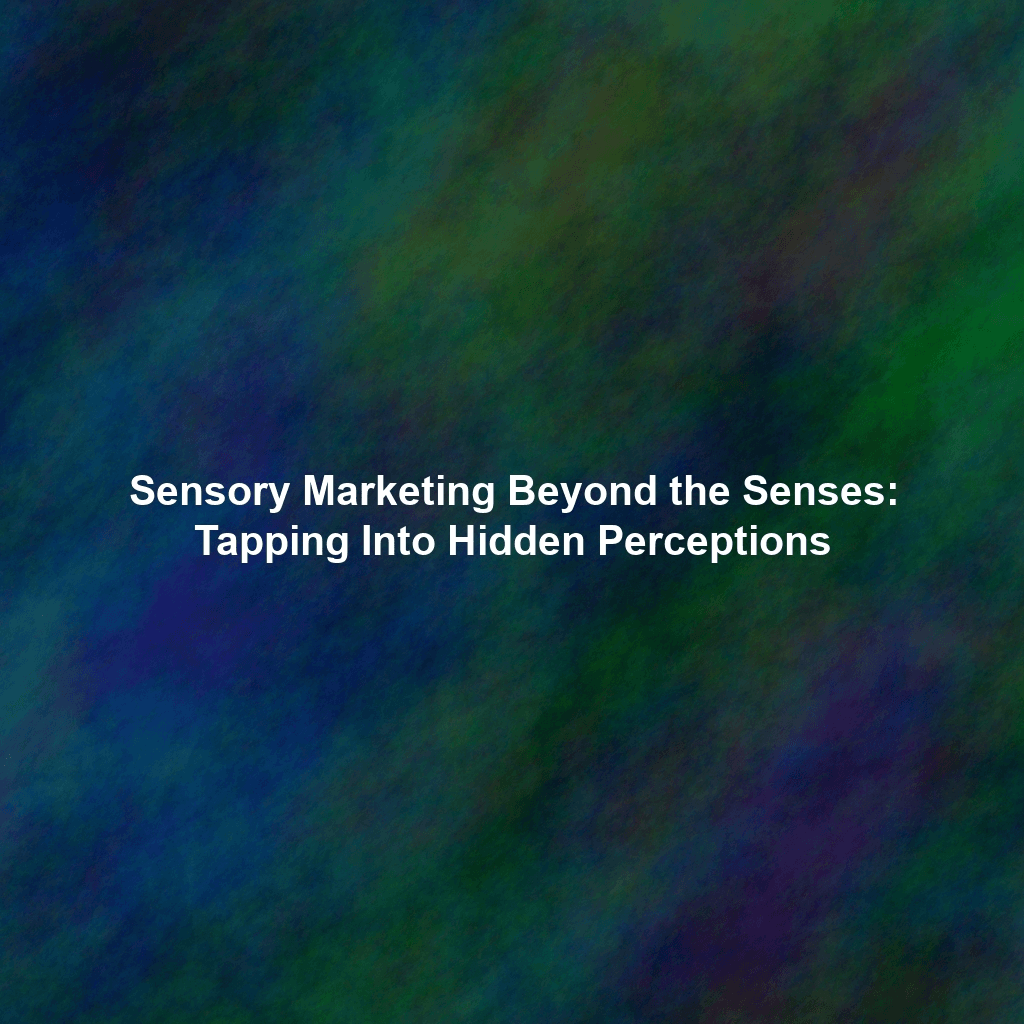We all know the power of sight, sound, smell, taste, and touch in marketing. A perfectly curated product photo, a catchy jingle, the aroma of freshly baked bread – these sensory experiences can powerfully influence purchasing decisions. But what if I told you there’s a whole other layer to sensory marketing, a realm where subtle, almost imperceptible cues can dramatically impact customer perception and drive growth? Forget the obvious; we’re diving into the weird and wonderful world of hidden sensory marketing. Get ready to unlock some unconventional strategies to hack your growth!
Beyond the Five Senses: The Sixth Sense of Marketing
Think about it: your brain is constantly processing information, often without your conscious awareness. Minor details in your environment can have a significant impact on your feelings, thoughts, and ultimately, your behavior. This is where the magic of hidden sensory marketing lies. It’s about leveraging these subconscious perceptions to create a desired effect. We’re talking about more than just nice smells and attractive visuals; we’re entering the territory of font psychology, layout logic, and color associations that go deeper than you might think.
Font Psychology: Words That Whisper (or Shout)
Believe it or not, the font you use can dramatically influence how your message is perceived. A playful, rounded font might be perfect for a children’s product, but it would likely undermine the credibility of a financial services firm. Consider these examples:
- Serif fonts (e.g., Times New Roman, Georgia): Project a sense of tradition, authority, and sophistication. Ideal for conveying trust and stability.
- Sans-serif fonts (e.g., Arial, Helvetica): Offer a clean, modern, and approachable feel. Suitable for tech companies and brands targeting a younger audience.
- Script fonts (e.g., Brush Script, Lobster): Can convey elegance, creativity, and a personal touch. Use sparingly for headings or accents.
Weird Marketing Trick: Increase conversion rates by using a slightly larger font size for your call-to-action buttons. Even a subtle increase can draw the eye and encourage clicks. Test different font weights (boldness) to see what resonates most with your audience.
Website Layout: The Silent Persuader
Your website layout is more than just aesthetics; it’s a sensory experience that guides users through your content and influences their decisions. A cluttered, confusing layout can overwhelm visitors and drive them away. A clean, intuitive design, on the other hand, can create a sense of calm and control, leading to higher engagement and conversion rates.
Weird Marketing Trick: Leverage the “visual hierarchy.” Place your most important content (e.g., product images, key benefits) in areas that naturally draw the eye, like the top-left corner or in the center of the page. Use white space strategically to create breathing room and direct attention.
Color Psychology: Painting a Picture with Perception
Color is a powerful influencer of emotions and behavior. Different colors evoke different feelings and associations. Understanding these associations can help you create a brand identity and marketing materials that resonate with your target audience.
- Red: Excitement, passion, urgency. Use for sales and promotions.
- Blue: Trust, stability, calmness. Ideal for financial institutions and healthcare providers.
- Green: Nature, health, wealth. Suitable for eco-friendly brands and wellness products.
- Yellow: Optimism, energy, happiness. Use to grab attention and create a positive vibe.
Weird Marketing Trick: Use contrasting colors strategically. A bright, contrasting call-to-action button on a neutral background can significantly increase click-through rates. Be mindful of cultural differences in color associations.
The Power of Sound (Beyond the Jingle)
While jingles and background music are standard fare in sensory marketing, consider the subtler ways sound can influence perception. For example, the sound of crackling fire in a restaurant during winter can create a sense of warmth and comfort. The sound of gentle waves on a website selling beach vacations can enhance the feeling of relaxation and escapism.
Weird Marketing Trick: Optimize your website loading speed. The faster your site loads, the less frustrating the experience for users. A slow-loading site can create a subconscious sense of impatience and negativity, ultimately impacting your brand perception.
Texture and Visual Weight: More Than Meets the Eye
Even on a digital platform, texture and visual weight play a role. A website with a lot of heavy graphics and dark colors can feel oppressive, while a website with light textures and pastel colors can feel airy and inviting. Using whitespace effectively is key here.
Weird Marketing Trick: A/B test different background textures on your website. Subtle textures can add depth and visual interest, making your site feel more engaging and premium.
Putting It All Together: A Holistic Sensory Strategy
The key to successful hidden sensory marketing is to create a holistic strategy that considers all the subtle cues that can influence customer perception. Don’t focus on just one element; think about how all the elements work together to create a cohesive and compelling experience. Always A/B test your changes and analyze the data to see what resonates most with your audience.
In conclusion, sensory marketing extends far beyond the obvious senses. By understanding the power of subtle cues like font psychology, website layout, and color associations, you can unlock a new level of influence over customer behavior and perception. Embrace these weird marketing tricks, test them rigorously, and watch your growth skyrocket.
 Skip to content
Skip to content

